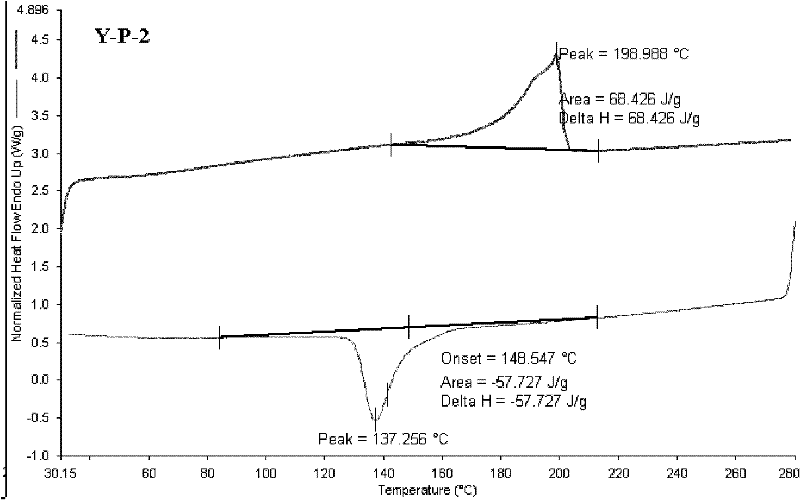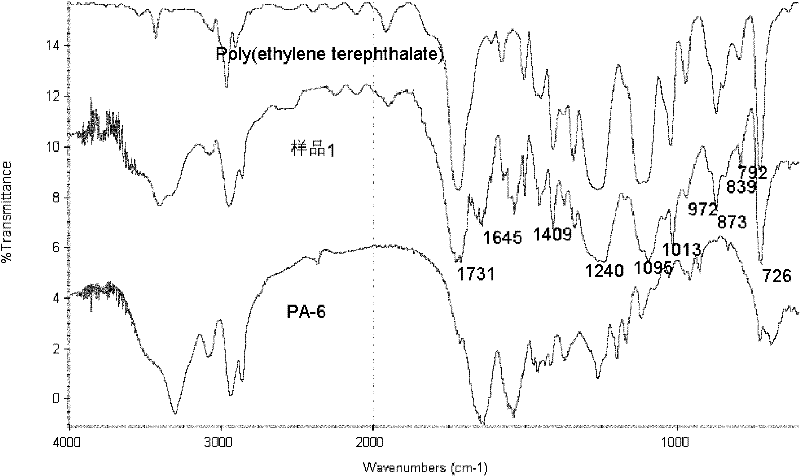Polyester-polyamide copolymer and synthetic preparation method thereof
A technology of polyamide copolymer and polyamide, which is applied in dyeing, textiles and papermaking, can solve the problems of poor compatibility between nylon and polyester, achieve uniform dyeing, increase tensile elongation at break, and improve the existing effect of technology
- Summary
- Abstract
- Description
- Claims
- Application Information
AI Technical Summary
Problems solved by technology
Method used
Image
Examples
Embodiment 1
[0083] Mix 800g of dimethyl terephthalate (DMT) with 521g of ethylene glycol, 30g of propylene glycol, and 0.27g of tetrabutyl titanate evenly, then add it to the reaction kettle, raise the temperature to 200°C, and carry out the reaction for 60 minutes. 99% of the amount, the end of the transesterification reaction. Then add 0.43g of tetrabutyl titanate polycondensation catalyst, after heating up to 230°C, add 115g of nylon 6 intermediate polymer with a relative viscosity of 2.0, then heat up to 240°C, vacuumize to 50Pa, continue to heat up to 260°C, and the reaction proceeds for 4 hours, when the intrinsic viscosity of the polyester in the kettle is 0.82dL / g, the material is discharged to prepare a polyester-polyamide chip with a melting point of 220-252°C, which contains a mass of polyamide 12%.
Embodiment 2
[0085] Mix 800g of dimethyl terephthalate (DMT) with 521g of ethylene glycol, 35g of butanediol, and 0.22g of tetrabutyl titanate evenly, then add them to the reaction kettle, raise the temperature to 160°C, and carry out the reaction for 60 minutes. When reaching 98% of the theoretical amount, the transesterification reaction was terminated. Then add 0.4g tetrabutyl titanate polycondensation catalyst, heat up to 230°C, then add 68g of nylon 6 intermediate with a relative viscosity of 1.8, then heat up to 245°C, vacuumize to 50Pa, continue to heat up to 260°C, and the reaction proceeds for 5 hours, when the intrinsic viscosity of the polyester in the kettle is 0.85dL / g, the material is discharged to prepare a polyester-polyamide chip with a melting point of 210-220°C, which contains a mass of polyamide 5%.
Embodiment 3
[0087] 1) transesterification reaction
[0088] Add 800g of dimethyl terephthalate and 521g of ethylene glycol, 15g of propylene glycol and 25g of butanediol into the reaction kettle, then add 0.12g of tetrabutyl titanate as a catalyst to carry out transesterification reaction at 220°C, the reaction time For 40 minutes, when the fraction reaches 98% of the theoretical amount, the transesterification reaction is terminated to obtain the transesterification reaction product;
[0089] 2) Copolymerization reaction
[0090] Add 0.25g of tetrabutyl titanate polycondensation catalyst to the transesterification reaction product obtained in step 1), then raise the temperature to 230°C, add 63.4g of nylon 6 polymer with a relative viscosity of 1.5 for copolymerization reaction, when the temperature reaches 240°C , pump a high vacuum, keep the vacuum at 30Pa, continue to heat up to 255°C, and react for 5 hours. When the intrinsic viscosity reaches 0.85dL / g, the material is discharged to...
PUM
| Property | Measurement | Unit |
|---|---|---|
| tensile strength | aaaaa | aaaaa |
| melting point | aaaaa | aaaaa |
| tensile strength | aaaaa | aaaaa |
Abstract
Description
Claims
Application Information
 Login to View More
Login to View More - R&D
- Intellectual Property
- Life Sciences
- Materials
- Tech Scout
- Unparalleled Data Quality
- Higher Quality Content
- 60% Fewer Hallucinations
Browse by: Latest US Patents, China's latest patents, Technical Efficacy Thesaurus, Application Domain, Technology Topic, Popular Technical Reports.
© 2025 PatSnap. All rights reserved.Legal|Privacy policy|Modern Slavery Act Transparency Statement|Sitemap|About US| Contact US: help@patsnap.com



